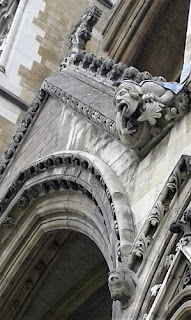And in this sprawling mass there is
order. If you measured the distance from every point within the
London area to the nearest form of public transportation, be that
bus, tube (subway), or regional train, I wonder what the maximum
distance would be. Surprisingly small, I'm sure. You probably never
have to walk more than about 6 or 7 minutes to reach some form of
public transportation, and even that guess might be high.
London is an interesting and eclectic
mix of the world. The city has culture, but not just from Britain,
instead from around the world. The city has history, but not just
from Britain, instead from around the world. The city has food, but
not just from Britain, instead from around the world.
As an example, we had only recently
come from Athens. In Athens we went to see the Acropolis and the
Parthenon. And we learned there that there are many metopes and
sculptures from the Parthenon that are now in the British Museum. So
while in London, we went to the British Museum and saw parts of the
Parthenon. That's not all we saw there, just one example.
 |
| This dragon is made entirely out of old weapons |
We learned about beheadings and other
lovely pieces of history at the Tower of London. We ate Indian food
which was way more flavored of coconut than we expected. Even in
South Africa, which has a British past, there was not nearly so much
coconut in all the dishes. (I mean, I expect some coconut flavor in a
korma, but not in a tikka masala. Am I right?)
 |
| This is where Anne Boleyn was beheaded. Well, I don't think it was a glass monument back then. |
I particularly enjoyed our visit to
Westminster Abbey. It is a beautiful abbey with a fascinating
history. Plus, so many famous authors, musicians, scientists, and
kings and queens are buried there. We saw the burial place of Isaac
Newton, Geoffrey Chaucer, and Richard Brinsley Sheridan to name a
few. I realize that Sheridan is not nearly as famous as the other
two, but I am a fan of his. We did see Dickens, of whom I am not as
big a fan. But given that the title of my post is a play on one of
his works, I suppose in fairness I should mention his story.
Here's the story. In Dickens' will, he
specified that he did not want to be buried in Westminster Abbey. I
don't remember where he said he wanted to be, but it was not in the
Abbey. But he was incredibly popular with the working class of London
who felt he had done so much for him. They demanded that he be buried
in the abbey with all honors. So the government overruled the will,
buried him in Westminster Abbey, kept the grave open for several
days, and allowed streams of people to come in and drop flowers for
him on his coffin.
It's a pretty good story even if you're
not a huge Dickens fan.
Here's another one. In one of the
chapels where kings are buried, Oliver Cromwell was buried as well.
WAS. So Cromwell led a rebellion which became a civil war. He had the
rightful king killed and established himself as Lord Protector,
basically a king without royal claim. He died of tertian ague
(malaria) and was buried in Westminster Abbey. His daughter also died
around then and was buried there.
A couple years later the monarchy was
reestablished with the former king's son being put back on the
throne. Then, just to show what happens to traitors, they had
Cromwell's body dug up. Next they hanged it. After they hanged it for
a couple days, they took it down and then beheaded it.
I guess the royalists made their point
about the fate of all traitors. But it seems like the germs had
already succeeded where up until then they had failed.
They were nice enough to leave
Cromwell's daughter in the Abbey.
There are amazing sights in the city.
Some of them are architectural.
 |
| How great is it that the sculptor had to include the tongue? |
Others are logistic. I guess you have
to fit cars somewhere, right?
 |
| No, it's okay. We can squeeze past. Why would we want the sidewalks for walking? |
I wouldn't say I felt right at home in
London, but in many ways it was quite comfortable. The accents are
different, but the language is the same and easily understandable.
The food in the grocery stores is more or less the same as home.
Though, did Kellogg's make changes to some of their cartoon
characters or do Snap, Crackle, and Pop just have to have a different
“look” for the Brits?
 |
| Who are these guys? |
I guess you just never know who you'll
find in this candidate for capital of the world.
I should note, I doubt the British want
London to be the capital of the world. At present, they are deciding
if they even want to be part of the European Union. So a world
government doesn't seem likely to be part of their agenda. Just
wanted to put that out there before the New Yorkers start trolling me
about why their city would be a better capital. Preemptive defense.
No comments:
Post a Comment